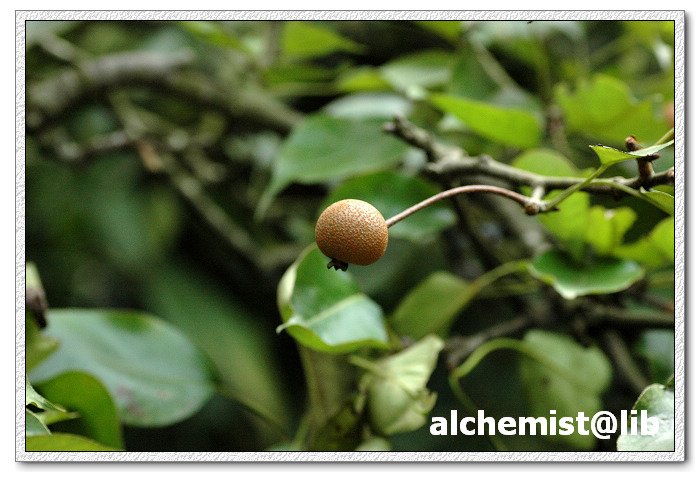- Scientific Name: Pyrus pyrifolia (Burm.f.) Nakai
- Ref: Bot. Mag. (Tokyo) 40:564. 1926
- Synonyms: Ficus pyrifolia Burm.f; Pyrus serotina Rehder
- English Common Name: sand pear, Asian pear, Chinese pear, Korean pear, Japanese pear
- Chinese Common Name: 沙梨 shālí, 水梨 shuǐlí, 苹果梨 píngguǒ∙lí, 黄金梨 huángjīn∙lí
- Japanese Common Name: ナシ [梨] nashi, ヤマナシ [山梨] yamanashi, ニホンヤマナシ [日本山梨] nihonyamanashi
- Family: Rosaceae
- Genus: Pyrus
- Distribution: Warm rainy regions; 100–1400 m. Anhui, Fujian, Guangdong, Guangxi, Guizhou, Hubei, Hunan, Jiangsu, Jiangxi, Sichuan, Yunnan, Zhejiang [Laos, Vietnam].
- Photo: 06/21/2009, South China Botanical Garden, Guangdong
Trees to 7–15 m tall. Branchlets purplish brown or dark brown when old, terete, tawny villous or tawny tomentose when young, soon glabrescent, glabrous when old, sparsely lenticellate; buds narrowly ovoid, apex obtuse; scales tomentose at margin and apex. Stipules caducous, linear-lanceolate, 1–1.5 cm, membranous, margin villous and entire, apex acuminate; petiole 3–4.5 cm, initially tomentose, glabrescent; leaf blade ovate-elliptic or ovate, 7–12 × 4–6.5 cm, glabrous or brown lanate when young, base rounded or subcordate, rarely broadly cuneate, margin spinulose-serrate, apex acute. Raceme umbel-like, 6–9-flowered; peduncle sparsely pubescent when young; bracts caducous, linear, 1–1.4 cm, membranous, villous at margin, apex acuminate. Pedicel 3.5–5 cm; sparsely pubescent when young. Flowers 2.5–3.5 cm in diam. Hypanthium cupular, abaxially glabrous. Sepals triangular-ovate, ca. 5 mm, abaxially glabrous, adaxially brown tomentose, margin glandular denticulate, apex acuminate. Petals white, ovate, 1.5–1.7 cm, base shortly clawed, apex rounded. Stamens 20, ca. 1/2 as long as petals. Ovary 5- or 4-loculed, with 2 ovules per locule; styles 5, rarely 4, nearly as long as stamens, glabrous. Pome brownish, with pale dots, subglobose, 2–2.5 cm in diam., (4- or)5-loculed; sepals caducous; fruiting pedicel 3.5–5.5 cm, subglabrous. Fl. Apr, fr. Aug. 2n = 34*, 51*. (Flora of China)
